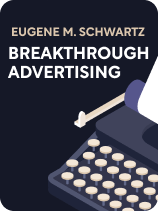

This article is an excerpt from the Shortform book guide to "Breakthrough Advertising" by Eugene M. Schwartz. Shortform has the world's best summaries and analyses of books you should be reading.
Like this article? Sign up for a free trial here.
What is the point of customer research? How can customer research increase sales numbers?
There are three areas of customer research that will help you target the most relevant customer need. In Breakthrough Advertising, Eugene M. Schwartz teaches you how to write up excellent headlines based on the findings from your customer research.
Below we’ll look at why headlines and customer research are important in advertising.
The Three Purposes of Headlines
According to Schwartz, the headline is the first and most important component of the advertisement that you should work on when thinking about conducting customer research. This is because a headline serves three purposes:
1) It captures attention by making a dramatic statement or inspiring curiosity. For example, “If you don’t read this, you’ll lose $1,000 this year,” or, “The money-saving secret fuel companies don’t want you to know.”
(Shortform note: Research backs up the necessity of provoking interest or stimulating curiosity with your headline: The average attention span is just 8.25 seconds. If you don’t engage people’s attention within this time, they’ll automatically switch their attention to something else and you’ll lose your chance of appealing to them.)
2) It resonates with what customers want and promises to fulfill a specific need. Customers rely on headlines to judge whether the advertisement’s copy is relevant to them and, therefore, worth reading. For example, the headline “Fill your gas tank for half the price,” is highly relevant to budget-conscious car drivers, so they’ll have a good reason to read the rest of the copy. Meanwhile, non-drivers will have little reason to learn more by reading the rest of the copy.
(Shortform note: Charles Duhigg (The Power of Habit) sheds light on why people scan headlines and automatically ignore advertisements that don’t feel relevant to their needs. Your brain seeks out ways to avoid information overload so that it can function efficiently. It achieves this by creating automatic routines and decisions based on what you do or pay attention to most often. These stored patterns allow you to get through your day without having to pause and consciously think about everything you do—they account for more than 40% of your daily decisions and behaviors, including what advertisements you pay attention to.)
3) It establishes the premise that your copy will expand upon. For example, following from the headline above about half-price gas, readers can expect the copy to address how expensive gas is and why this is a bad thing before explaining how to get a cheaper deal.
(Shortform note: Research adds additional insights into how headlines influence a reader’s expectations of the copy: Headlines affect what parts of the copy readers focus on and what information they’re able to recall. A headline frames the copy by drawing attention to certain details or specific points of view that influence the way readers perceive and interpret the text. Because they expect the copy to discuss the content within the headline, they actively seek out the information that supports those details. And, because readers pay more attention to the information that upholds the headline, the details they later recall coincide with the headline’s main theme.)
Schwartz argues that the key to creating a headline that captures attention, resonates with customers, and establishes the premise that your copy will expand upon lies in researching three things about your customers:
- What they want
- How aware they are of your product
- How aware they are of competitive products
Let’s explore each of these three areas of research in detail.
Research Area #1: What Customers Want
To create a compelling headline, you must first understand what customers want. Schwartz argues that it’s not possible to convince customers to want something. Instead, you must understand what they already want and figure out a way to frame your product as the only solution to fulfill their needs.
Schwartz claims that you can effectively frame your product by following a two-step process:
- Analyze your product.
- Align your product with the most dominant customer need.
Let’s explore these two steps in detail.
Step #1: Analyze Your Product
Schwartz argues that the more you know about your product, the easier you’ll find it to create positive associations between what customers want and what your product offers. He suggests that you list the materials used to create the product, the technical specifications, the aesthetic details, and all of the different ways customers might want to use your product.
For example, say you have a dating app you want to advertise, and you’re analyzing how it functions and what it offers. You note all of the different features the app includes, such as the ability to view other members’ profiles and chat directly with them, the number of members it hosts, the advertisement-free interface, and the subscription price. You also note that members may want to use it to develop friendships as well as romantic relationships.
Step #2: Align Your Product With the Predominant Customer Need
Once you’ve noted every detail about your product, group each item on your list against a specific customer need that it satisfies. This will help you understand what motivates customers to purchase products similar to yours. Schwartz notes that, as you connect your product’s attributes to specific customer needs, you should consider that customer needs fall into two categories:
- Primal needs: These are deep-rooted emotional needs that all customers seek to satisfy, such as feeling healthy, happy, accomplished, or loved. For example, customers might subscribe to dating apps because they’re motivated by the need to feel loved.
- Shifting needs: These are surface-level needs that fluctuate according to market trends and expectations. For example, customers might choose your dating app because it promises an advertisement-free interface. They only want this feature because most paid apps in the market function this way—thus, leading customers to expect an advertisement-free interface for all paid apps.
Finally, choose the customer need that applies to the largest potential market for your product and target this need in your headline. For example, your research indicates that the need for love motivates more customers than the need for an advertisement-free interface. Therefore, you choose to frame your app as the best solution for finding love.
Research Area #2: Customer Awareness of Your Product
Once you’ve chosen the specific customer need your headline will target, find out how much they already know about and feel like they need your product. This will help you determine what type of information you should put in your headline to capture attention.
According to Schwartz, customers move through five different levels of awareness as they learn more about your product. Each level of awareness determines how much information you must provide in the headline to get customers to consider your sales pitch.
Schwartz suggests that you should find out what level of awareness the majority of your customers currently have and write a headline that caters to how much they know about your product.
Research Area #3: Customer Awareness of Your Competitors’ Products
Once you’ve figured out what your customers want and how aware they are of your product, find out how aware customers are of competitive products. This will help you determine how much emphasis to place on distinguishing your product from similar versions in the market.
Let’s explore Schwartz’s advice for distinguishing your product for two different types of customers:
- Customers who are unaware of competitive products
- Customers who are aware of competitive products
Customer Group #1: Unaware of Competitive Products
According to Schwartz, if customers aren’t aware of similar versions of your product, your headline should be as simple and direct as possible. For example, “Finally, an effortless way to find love!”
Customer Group #2: Aware of Competitive Products
If customers are aware of a few similar versions of your product, Schwartz suggests that, instead of inventing a new headline, you simply expand on your competitors’ headlines and elaborate on why your product is better than all other versions. For example, if a competitor uses the headline, “An easy way to find love,” you can expand on their claim with: “The fastest and easiest way to find love.”
If customers are aware of many versions of your product, they won’t be as receptive to new advertisements—because they’ve already heard all of the claims and have lost interest in this type of product. Schwartz suggests two ways your headline can revive customer interest in your product:
- Emphasize a new, distinct benefit to distinguish your product from what’s currently on the market. For example, “The only app to guarantee your perfect match in under 60 seconds!”
- Express an emotion or attitude to appeal to these customers. For example, “For those who know that life should be better.”

———End of Preview———
Like what you just read? Read the rest of the world's best book summary and analysis of Eugene M. Schwartz's "Breakthrough Advertising" at Shortform.
Here's what you'll find in our full Breakthrough Advertising summary:
- Why the headline is the most important component of an advertisement
- Specific techniques you can use to create captivating headlines
- Persuasive methods you can apply to write compelling copy






